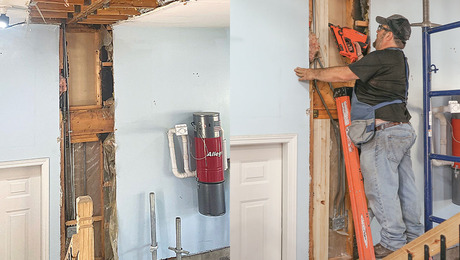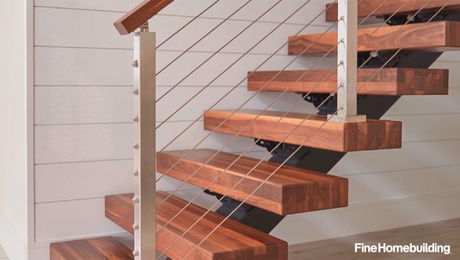We have a house where the dryer currently is vented about 35 feet through a crawl space with a combination of plastic flex with a few elbows thrown in. It is a one story house with a low slope (2:12) Carlisle rubber roof (brand new). If we vented the dryer up instead, the pipe would drop to about 12 feet in length.
We need to come up with a solution for this. The pipe must be 4″ metal and rigid enough to work with a neoprene roof flash. The roofer has expressed concern about the pipe getting too hot for the neoprene boot ( Carlisle says 140F max ). Flashing a pipe to rubber any other way is problematic. The termination point on the roof is a question also. Water can’t enter the pipe, so we have considered a 180 gooseneck for the top of the pipe. Bugs and birds are an issue with this. We have considered a 90 el on the top with some form of louver or cap vent like this.
Anyone ever done one of these ? My questions are: what type of rigid seamless pipe should we use ? is the temperature of the pipe a problem with the neoprene boot ? ( the boot will be about 10 feet above the dryer vent ) how do we terminate at the top of the pipe ?
carpenter in transition















Replies
You can use glav. or copper downspout (4" round). I don't know about the heat issue, but you could buy or have fabricated a metal cone to surround the pipe with a flange on the bottom to be flashed to the rubber. This should eliminate the heat problem. I can't imagine dryer exhaust would be more than 140 degrees.
Since its inception almost 30 years ago, the internet has been transformed from a primitive device for sharing thoughts and ideas, into a massive network where people pay to connect and read advertisements they don't want, while calling each other "asshats".
Thanks. I thought about using downspout but the idea of the seam concerned me from a leak standpoint.
How would you counterflash the cone ?
carpenter in transition
The counter flash is called a storm collar..it tightens up with a screw like a hoseclamp, the whole thing looks like what a dog gets around his neck after a wound or surgery..look at chimney parts..there are storm collars for almost all size pipes and if not it is easily fabbed yerself
Spheramid Enterprises Architectural Woodworks
Repairs, Remodeling, Restorations.
How would you counterflash the cone ?
Solder it to the pipe or preferably, buy or fabricate a storm collar. Another idea I've had since I posted is to use a four inch (or larger) B vent pipe. That stuff's not too expensive, stays cool, and the parts are all available off the shelf. Most of the caps use rings rather than screen to keep the varmints out, so they shouldn't be clog prone. No damper is the only flaw I see so far. Maybe someone else will chime in with pros and cons on this. Good luck.
Since its inception almost 30 years ago, the internet has been transformed from a primitive device for sharing thoughts and ideas, into a massive network where people pay to connect and read advertisements they don't want, while calling each other "asshats".
I would not solder the cone to the pipe. Too much thermal expansion going on here.
The rubber roofer's concern for heat is overkill. A single wall pipe would be adequate but a "B" pipe is definitely best.
The roof cone - "Witches Hat" - is the kind of flashing to use - not flashing neopreme directly to the pipe. Then the neoprene flashes the base of it to the roof.
There are half a dozen kinds of terminal caps to prevent birds, bugs and backflow available.
Welcome to the Taunton University of Knowledge FHB Campus at Breaktime. where ... Excellence is its own reward!
Install a double pipe -- a 5" or so pipe that the other one runs through. End both pipes at about the same height, then install the hood/cap on the inner pipe, sealing it to the outer one somehow. See if you can find a hood/cap that overlays the outer pipe, so the sealing doesn't have to shed rain.
They make dryer vents designed for rooftop mounting. They're designed to be mounted flush, but probably would work OK if elevated a few inches.
Another option is to build a false chimney to house the vent. Then you could put an elbow at the top and use a standard sidewall vent.
A completely different option would be to rebuild the existing line with all metal and adding a booster fan.
Carlisle, or at least your roofer's supplier, should have storm collars in stock for a variety of pipe sizes. I'm suprized your roofer can't solve this issue. To keep the Carlisle warranty in force you may need to use the manufacturer's recommended collar and adhesive.
The storm collar, in a preformed cone shape, similar to the ones on a pitched roof (without the metal portion) fits snuggly over the vent pipe and adheres directly to the membrane. A double wall "B" vent, used on gas fired water heaters, is probably the safest solution. The roofing suppler or HVAC supplier should have roof vent caps in stock. I too doubt if a dryer vent heats to 140 but it wouldn't hurt to test it. I have heard of house fires starting at the dryer though usually from not removing lint from the vent pipe.
I had the same feelings about the "roofer". Hios lack of positive suggestion or solution speaks of inexperience in the craft. He may be very conservative and precise bu nature, or it could be that he has recently finished the schooling for this product and the manufacturer has drummed into him that NOTHING shall be done to it without their specific and express permission.
Welcome to the Taunton University of Knowledge FHB Campus at Breaktime. where ... Excellence is its own reward!
Thanks for all of your input. The roofer is highly qualified and has been around for decades. I think I caught him in the middle of something. I spoke with their road super and he recommended your exact method of install.
Our guys just found that a bathroom vent fan was vented from the ceiling down into the crawl space................
with 4" vinyl flex..............
and it was connected to the 4" vinyl flex dryer pipe !
carpenter in transition
Of course the vinyl flex was the sin.
Welcome to the Taunton University of Knowledge FHB Campus at Breaktime. where ... Excellence is its own reward!